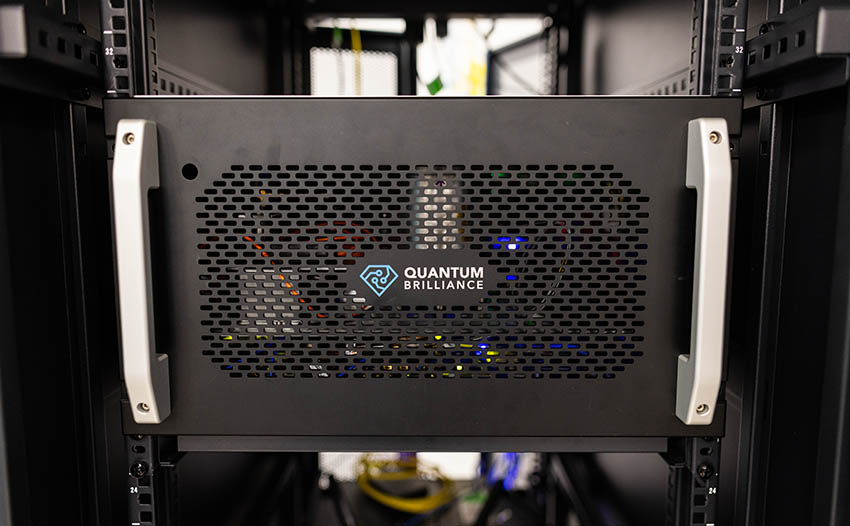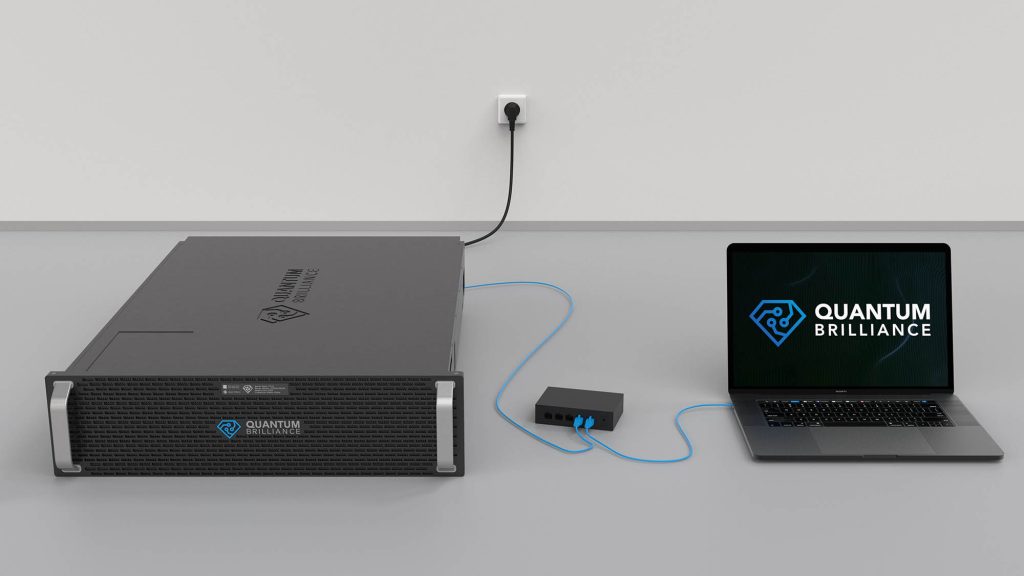Founded in 2019, Quantum Brilliance is a venture-backed quantum products and solutions company developing diamond-based quantum computers supported by software and applications. The Australian-German deep-tech start-up has global partnerships in the Americas, EMEA and Asia Pacific, working with governments, supercomputing centres, research organisations and industry.
Unlike large mainframe quantum computers, Quantum Brilliance’s small-form devices do not require cryogenics, vacuum systems or precision laser arrays, and so consume significantly less power and enable deployment onsite or at the edge.
The company’s first installed diamond quantum ‘accelerator’ at the Pawsey Supercomputing Centre achieved the first-ever instance of an algorithm running between an on-premises quantum computer and supercomputer, validating that quantum and classical computing systems can communicate to solve complex challenges.
The company is working to further miniaturise its technology from the size of a desktop PC to the size of a semiconductor chip that can be used on any device, wherever classical computers exist today, unlocking practical quantum computing for everyone.
Interview with Dr. Mark Mattingley-Scott, Chief Revenue Officer at Quantum Brilliance.
Easy Engineering: What are the main areas of activity of the company?
Mark Mattingley-Scott: Quantum Brilliance recently announced the full release of the Qristal SDK, an open-source software development kit for researching applications that integrate the company’s portable, diamond-based quantum accelerators. The Quantum Brilliance Qristal SDK is available for anyone to develop and test novel quantum algorithms for real-world applications specifically designed for quantum accelerators rather than quantum mainframes.

Also, within Quantum Brilliance’s software suite is the Qristal Emulator. Bundled with high-performance NVIDIA DGX systems, the Qristal Emulator delivers the world’s leading solutions for enterprise AI infrastructure at scale. Customers will be able to design and run their own quantum computing solutions locally, without need for cloud connectivity. Users will be able to determine the number of qubits that will be required to outperform classical computers in hybrid classical/quantum applications in data centres, aerospace, and more. Potential use cases include massively parallelised clusters of accelerators for computational chemistry and embedded accelerators for edge computing applications such as robotics, autonomous vehicles, satellites and mobile devices.
E.E: What’s the news about new products?
M.M.S: Quantum Brilliance’s goal is to enable mass deployment of its quantum technology to propel industries to harness edge computing applications and next-generation supercomputers. A key to this will be making quantum computing an everyday technology, and for that to happen, the technology must be useful. Coming next will be software that allows users to further explore “quantum utility” – that is, enhanced performance for useful tasks over classical computers of similar size, weight and power – and discover new use cases where quantum hardware will deliver quantum utility. Quantum Brilliance looks forward to advancing its emulator; expanding on the idea of being able to investigate and drill down into identifying where quantum computing will be economically beneficial; and tooling to achieve that kind of enterprise advantage.
E.E: What are the ranges of products?
M.M.S: In terms of enterprise sectors and spaces, Quantum Brilliance products, services and solutions are industry-agnostic, edge, workstation-deployable, massively parallel and high-performance-computing-deployable. If a customer deploys our quantum computer in an HPC center, it would do a lot of the heavy lifting for some specific types of algorithms, keeping some of the other computers from having to do all the work. Defense is a strong area for Quantum Brilliance, with potential in edge computing on autonomous vehicles, satellites, and more.

E.E: At what stage is the market where you are currently active?
M.M.S: The market is mostly innovators. Also, the quantum computing education market. As early adopters, where Quantum Brilliance is active is in the integration and preparation of markets, which are still at the innovator stage.
E.E: What can you tell us about market trends?
M.M.S: One current market trend is the increasing awareness among consumers based on their learnings from the quantum computing education market.
The sophistication of knowledge and context of the future users of quantum computing is rapidly increasing. And they are asking themselves the the important questions, how do I deploy it? What’s it good for? How much energy does it use?
And in the end, they are finding that cloud deployment is probably not the answer for HPC because everything must be placed into the cloud.
For most companies, if you look at their value creation, it’s either with raw material being made into something of higher value or by creating value through association of data. That applies to the automobile industry, banking, insurance, logistics, the list goes on, which means they have data everywhere. Companies don’t want to place their highest value creation, data processing computation, in somebody else’s cloud platform. It’s like giving away The Crown Jewels. That’s why big banks and logistics companies still have their own huge computer centres, because it is valuable computation. They are not giving away the data and they are not giving away the algorithms.
Compute deployment for HPC compute workloads is the way to go. In that space, a number of the bigger quantum providers fall off of the radar.

E.E: What are the most innovative products marketed?
M.M.S: Aside from our hardware, Qristal SDK and Qristal Emulator, I’m really impressed with ParityQC and their alternative underlying computational foundation based on a different way of interpreting pairs of qubits. It’s a new paradigm on how to encode optimization problems on quantum computers.
E.E: What estimations do you have for 2023?
M.M.S: From an engineering point of view, you’re going to see the change in focus from physics R&D to engineering and manufacturing quantum computing components and equipment. This will really start to pick up by the end of the year, and I think it’s going to be one of the big topics in 2024 and 2025 as well. There will be less emphasis on research, and more on production. It will be a very important time for engineers.

